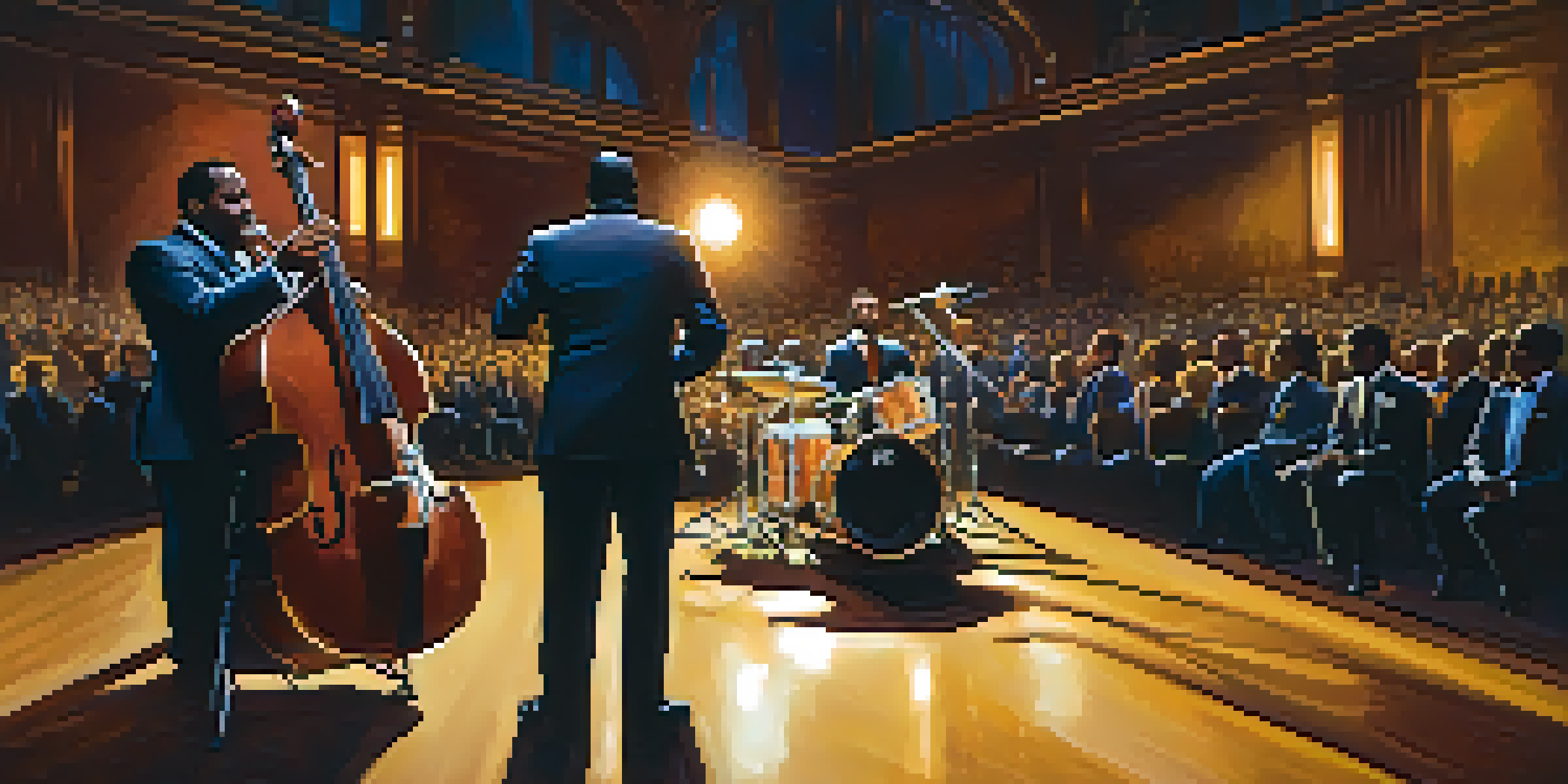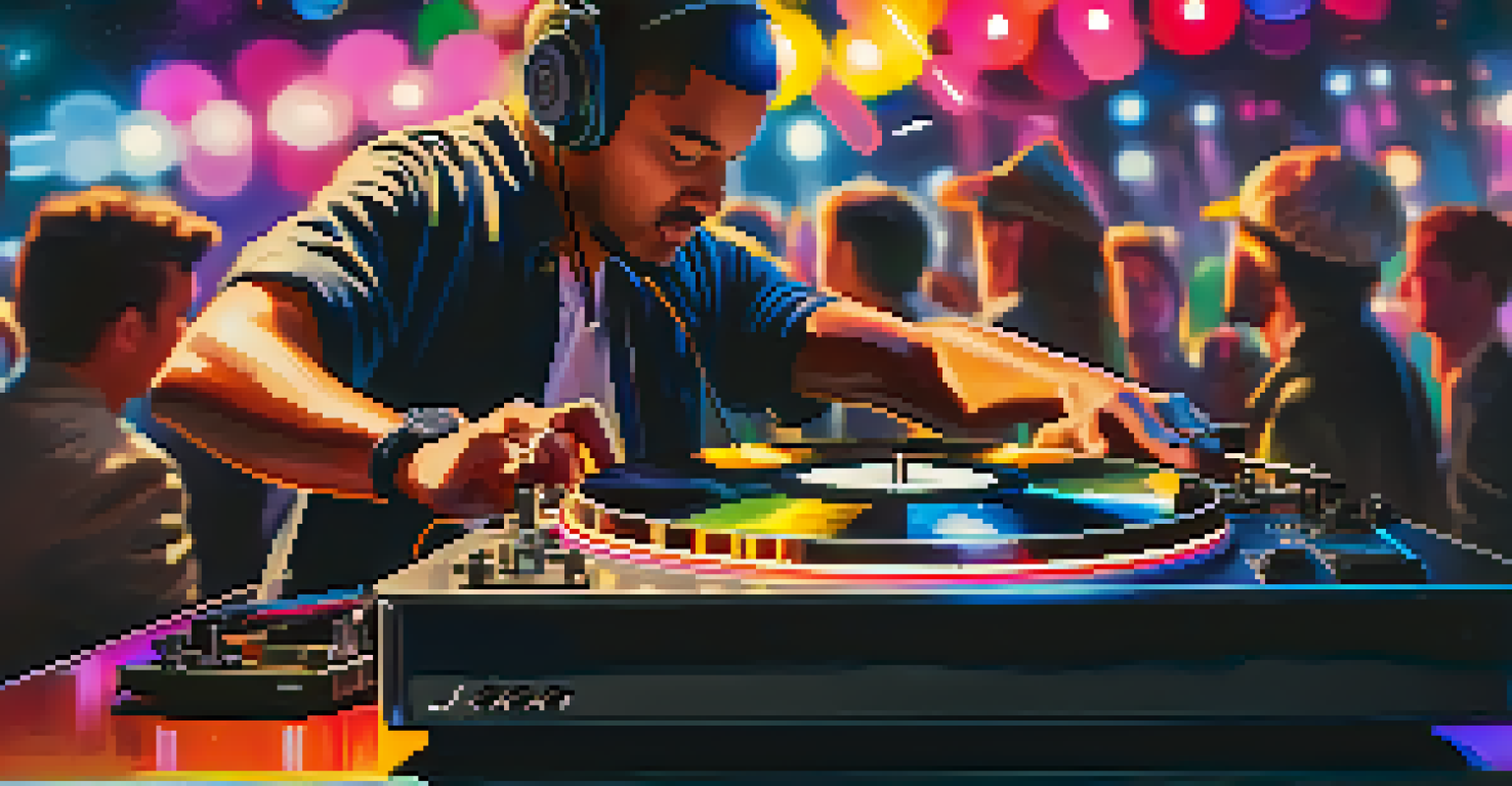Exploring the Relationship Between Jazz and Electronic Music

The Origins of Jazz: A Brief Overview
Jazz originated in the early 20th century, primarily in New Orleans, blending African rhythms with European musical traditions. This vibrant genre is characterized by its improvisational style and unique syncopation, inviting musicians to express themselves freely. As jazz evolved, it incorporated elements from blues, ragtime, and even folk music, creating a rich tapestry of sounds that resonates even today.
Jazz is the music of the moment, and it is the moment that we live in.
One of the core attributes of jazz is its emphasis on individual expression through improvisation, where musicians often take turns creating spontaneous melodies. This organic nature of jazz laid the groundwork for future genres, encouraging artists to experiment and push the boundaries of conventional music. The essence of jazz became a canvas for innovation, making it a significant cultural movement.
As jazz continued to evolve, it began to intersect with other musical styles, paving the way for future explorations into electronic music. The improvisational spirit of jazz invites parallels with electronic music's own quest for experimentation, leading to a fascinating relationship between the two genres that would unfold in the decades to come.
The Rise of Electronic Music: A New Frontier
Emerging in the mid-20th century, electronic music revolutionized how we create and experience sound. Utilizing technology such as synthesizers and drum machines, artists could manipulate audio in ways never thought possible. This genre quickly gained popularity, leading to the formation of various subgenres like techno, house, and ambient music.

One of the key features of electronic music is its ability to blend various influences, creating a diverse sound landscape. The incorporation of samples from different genres allows for a unique listening experience that resonates with a broad audience. As artists experimented with technology, electronic music became a playground for creativity, much like jazz had been for its pioneers.
Jazz and Electronic Music Fusion
The blending of jazz and electronic music has led to innovative sounds, with artists from both genres experimenting with each other's techniques.
The evolution of electronic music not only changed how music is produced but also how it is consumed, with the rise of digital platforms making it accessible to a global audience. This shift laid the groundwork for collaborations between electronic musicians and jazz artists, leading to exciting new sounds that challenge the boundaries of both genres.
The Intersection: Jazz Meets Electronic Music
The convergence of jazz and electronic music is a fascinating phenomenon that has produced some of the most innovative sounds of recent decades. Artists from both genres began to experiment with each other's techniques, blending live instrumentation with electronic elements. This fusion often results in rich, textured compositions that highlight the strengths of both styles.
The future of music is in technology, and we are just beginning to scratch the surface.
For instance, musicians like Herbie Hancock and Miles Davis began incorporating synthesizers and electronic effects into their jazz compositions, creating a new subgenre known as jazz fusion. This genre not only attracted jazz enthusiasts but also caught the attention of electronic music fans, expanding the audience for both styles. The experimentation didn't stop there; it continues to evolve today with new artists pushing the limits.
Moreover, electronic music producers often draw from jazz samples and improvisations to create fresh beats and melodies. This cross-pollination of ideas illustrates how both genres can inspire and elevate each other, showcasing the beauty of collaboration in the music world.
Notable Artists Blending Jazz and Electronic Music
Several artists have emerged as pioneers in the fusion of jazz and electronic music, creating unforgettable sounds that resonate with fans worldwide. For example, Flying Lotus seamlessly combines elements of jazz, hip-hop, and electronic music, crafting intricate soundscapes that showcase his unique musical vision. His work exemplifies the beauty of blending genres while maintaining a strong jazz foundation.
Another notable figure is Kamasi Washington, whose expansive compositions often incorporate electronic elements alongside traditional jazz instrumentation. His collaborations with electronic producers have resulted in dynamic tracks that push the boundaries of both genres. These artists exemplify how jazz can thrive in an electronic landscape, breathing new life into its classic roots.
Technology's Role in Music Evolution
Advancements in technology have shaped how jazz and electronic music are created and performed, enabling new sonic possibilities and collaboration.
The collaboration between jazz and electronic artists also extends to live performances, where improvisation and technology intertwine to create a captivating experience. This synergy not only enriches the listening experience but also highlights the dynamic nature of both genres, showcasing their potential for growth and innovation.
The Role of Technology in Jazz and Electronic Music
Technology plays a crucial role in the evolution of both jazz and electronic music, enabling artists to explore new sonic possibilities. From the introduction of electric instruments in jazz to the rise of digital audio workstations in electronic music, technology has shaped how musicians create and perform. This ongoing relationship continues to inspire fresh ideas and innovations.
For instance, the use of MIDI (Musical Instrument Digital Interface) allows musicians to control multiple devices and instruments from a single controller, making it easier to blend genres. This technology has become a staple in electronic music production and has found its way into jazz as artists experiment with new sounds. The ability to manipulate sound in real-time during live performances adds an exciting dimension to both genres.
As technology advances, it opens up even more avenues for collaboration between jazz and electronic musicians. From virtual reality concerts to AI-generated music, the potential for creativity is limitless, encouraging artists to experiment and redefine their musical boundaries.
The Impact of Jazz and Electronic Music on Culture
The fusion of jazz and electronic music has had a significant impact on contemporary culture, influencing various artistic disciplines beyond just music. This crossover has inspired visual artists, filmmakers, and dancers, creating an interdisciplinary dialogue that enriches the overall cultural landscape. The vibrant energy of both genres resonates across different art forms, fostering creativity and collaboration.
Music festivals and events celebrating this fusion have gained popularity, attracting diverse audiences eager to experience the unique sounds of jazz-infused electronic music. These gatherings offer a space for artists to showcase their work and connect with fans, further solidifying the relationship between the two genres. The collaborative spirit found in these environments reflects the essence of both jazz and electronic music.
Cultural Impact of Music Crossover
The fusion of jazz and electronic music influences various artistic disciplines and fosters a sense of community through shared musical experiences.
Moreover, the blending of these genres serves as a reminder of the power of music to unite people from different backgrounds and cultures. This harmonious relationship encourages listeners to explore new sounds and appreciate the richness of both jazz and electronic music, fostering a sense of community and shared experience.
Looking Ahead: The Future of Jazz and Electronic Music
As we look to the future, the relationship between jazz and electronic music promises to continue evolving in exciting and unpredictable ways. With new technologies emerging and artists eager to explore uncharted territory, we can expect even more innovative collaborations that challenge the norms of both genres. The spirit of experimentation that defines jazz is alive and well, ensuring that it remains relevant in the modern musical landscape.
Emerging artists are increasingly drawing inspiration from both jazz and electronic influences, creating unique sounds that reflect a new generation's diverse musical tastes. This blending of styles encourages a dynamic exchange of ideas, allowing for continuous growth and evolution within the music community. As a result, we may witness the birth of entirely new genres that redefine our understanding of music.

Ultimately, the relationship between jazz and electronic music highlights the beauty of artistic collaboration and the power of creativity. As both genres continue to inspire each other, we can look forward to a future filled with fresh sounds and innovative experiences, reminding us that music knows no boundaries.